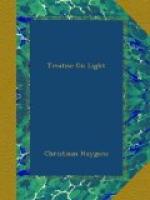Here BL and km are the sines of angles BKL, KBM; that is to say, of the angles PBA, QBC; and therefore they are to one another as the velocity of light in the medium A is to the velocity in the medium C. Then the time along lb is equal to the time along km; and since the time along bc is equal to the time along mn, the time along LBC will be equal to the time along KMN. But the time along AK is longer than that along Al: hence the time along AKN is longer than that along abc. And kc being longer than KN, the time along AKC will exceed, by as much more, the time along abc. Hence it appears that the time along abc is the shortest possible; which was to be proven.
CHAPTER IV
ON THE REFRACTION OF THE AIR
We have shown how the movement which constitutes light spreads by spherical waves in any homogeneous matter. And it is evident that when the matter is not homogeneous, but of such a constitution that the movement is communicated in it more rapidly toward one side than toward another, these waves cannot be spherical: but that they must acquire their figure according to the different distances over which the successive movement passes in equal times.
It is thus that we shall in the first place explain the refractions which occur in the air, which extends from here to the clouds and beyond. The effects of which refractions are very remarkable; for by them we often see objects which the rotundity of the Earth ought otherwise to hide; such as Islands, and the tops of mountains when one is at sea. Because also of them the Sun and the Moon appear as risen before in fact they have, and appear to set later: so that at times the Moon has been seen eclipsed while the Sun appeared still above the horizon. And so also the heights of the Sun and of the Moon, and those of all the Stars always appear a little greater than they are in reality, because of these same refractions, as Astronomers know. But there is one experiment which renders this refraction very evident; which is that of fixing a telescope on some spot so that it views an object, such as a steeple or a house, at a distance of half a league or more. If then you look through it at different hours of the day, leaving it always fixed in the same way, you will see that the same spots of the object will not always appear at the middle of the aperture of the telescope, but that generally in the morning and in the evening, when there are more vapours near the Earth, these objects seem to rise higher, so that the half or more of them will no longer be visible; and so that they seem lower toward mid-day when these vapours are dissipated.




